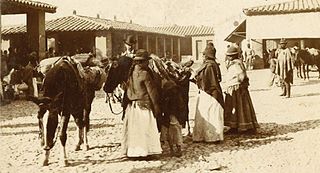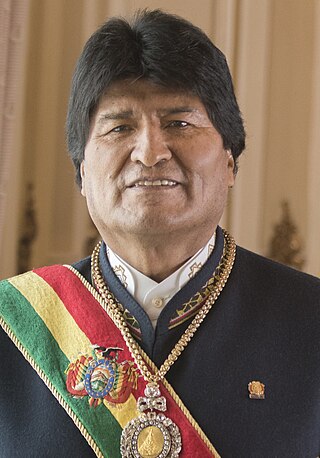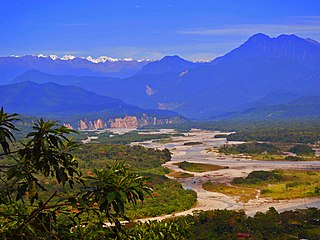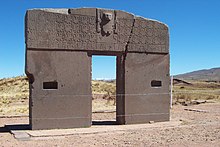Social protests and political mobilization
Revolution: 1952
Historically Indigenous people in Bolivia suffered many years of marginalization and a lack of representation. [4] However it was in the last decades of the twentieth century that saw a surge of political and social mobilization in Indigenous communities. [4] The 1952 Bolivian National Revolution that liberated Bolivians and gave Indigenous peoples citizenship still gave little to political representation to Indigenous communities. [4] It was in the 1960s and 1970s that social movements such as the Kataraista movement began to also include Indigenous concerns. [4] The Katarista movement, consisting of the Aymara communities, of La Paz and the altiplano, attempted to mobilize the Indigenous community and pursue an Indigenous political identity through mainstream politics and life. [5] Although The Katarista movement failed to create a national political party, the movement influenced many peasant unions such as the Confederacion Sindical de Trabajadores Campesinos de Bolivia (Unitary Syndial Confederation of Peasant Workers in Bolivia). [4] The Katarista movement of the 1970s and 80's died out by the end of the decade however many of the same concerns and issues rose again in the 1990s. [4]
Social movement: 1990s and 2000s
The 1990s saw a large surge of political mobilization for Indigenous communities. [4] President Sánchez de Lozada passed reforms such as the 1993 Law of Constitutional Reform to acknowledge Indigenous rights in Bolivian culture and society. However, many of these reforms fell short as the government continued to pass destructive environmental and anti-indigenous rules and regulations. [4] A year after the 1993 Law of Constitutional Reform passed recognizing Indigenous Rights, the 1994 Law of Popular Participation decentralized political structures giving municipal and local governments more political autonomy. [4] Two years later the 1996 Electoral Law greater expanded Indigenous political rights as the national congress transitioned into a hybrid proportional system, increasing the number of Indigenous representatives. [4]
Environmental injustice became a polarizing issue as many Indigenous communities protested against government-backed privatization and eradication of natural resources and landscapes. [6] Coca leaf production is an important sector of the Bolivian economy and culture, especially for campesinos and Indigenous peoples. [7] The eradication of coca production, highly supported by the U.S. and its War on Drugs and the Bolivian government spurred heavy protests by the Indigenous community. [6] One of the main leaders of the coca leaf movement, Evo Morales became a vocal opponent against state efforts to eradicate coca. The coca leaf tensions began in the region of Chapare in 2000 and became violent as protests against police officials and residents began. During this time protestors organized road blockades, and traffic stops to protest low prices. [8] Coca leaf producers continued to resist the government's policies on production further devaluing the peso and seized control of the peasant confederation (Confederation Sindical Unica de Trabajadores Campesinos de Bolivia). [9] With Evo Morales' leadership the cocaceleros were able to form coalitions with other social groups and eventually create a political party, the Movement Towards Socialism (MAS). [7]
Similarly, the 2000 “Water War” bought these protests to national attention. [10] The “Water War" began in the city of Cochabamba where the private company Bechtel began to increase rates for water after the government contracted out to privatize Cochabamba's water system. [10] When Cochabamba's residents realized that they could not afford to pay for this resource, they began to protest in alliance with urban workers, rural peasants and students. [9] The mass protest resulted in a state of emergency as clashes against the police and protestors became more violent. [5] The protests were largely successful and resulted in the reversal of the privatization. [5]
Additionally in 2003, as reliance on natural resources in Bolivia's economy grew, resistance came from Bolivia's Indigenous community in the form of the “Gas Wars”. [11] This conflict which culminated from the Water Wars, united coca farmers, unions and citizens to protest the sale of Bolivia gas reserves to the United States through the port of Chile. [10] Again, Indigenous peoples participated alongside miners, teachers and ordinary citizens through road blockades and the disruption of traffic. [10] Protests politics for social and economic reforms have been a consistent method for Indigenous mobilization and inclusion in the political process. [10] They have concluded in successful results and created a platform for Indigenous Rights. These protest movements soon made the way for legal and political changes and representation.
Indigenous March in 2011
In 2011 Bolivian indigenous activists started a long protest march from the Amazon plains to the country's capital, against a government plan to build a 306 km highway through a national park in indigenous territory. [12]
The subcentral TIPNIS, the Confederation of Indigenous Peoples of Bolivia (CIDOB), and the highland indigenous confederation CONAMAQ—supported by other indigenous and environmental groups—organized a march from Trinidad, Beni to the national capital La Paz in opposition to the project, beginning on 15 August 2011. [13]
"One of the latest tactics deployed by governments to bypass indigenous contestation is to consult non-native indigenous communities. This happened to communities in the case of the road project through Bolivia’s Isiboro Sécure National Park and Indigenous Territory (TIPNIS)."International pressure built up after Evo Morales’ government violently repressed a large indigenous march against a road project in “the massacre of Chaparina”. [14]
This led to the "Chaparina Massacre" - On September 25, 2011 national police brutally repressed indigenous marchers protesting the construction of a government-proposed highway through the TIPNIS indigenous territory and national park. [15]

Bolivia, officially the Plurinational State of Bolivia, is a landlocked country located in western-central South America. It is bordered by Brazil to the north and east, Paraguay to the southeast, Argentina to the south, Chile to the southwest, and Peru to the west. The seat of government and administrative capital is La Paz, which contains the executive, legislative, and electoral branches of government, while the constitutional capital is Sucre, the seat of the judiciary. The largest city and principal industrial center is Santa Cruz de la Sierra, located on the Llanos Orientales, a mostly flat region in the east of the country.

The demographic characteristics of the population of Bolivia are known from censuses, with the first census undertaken in 1826 and the most recent in 2012. The National Institute of Statistics of Bolivia (INE) has performed this task since 1950. The population of Bolivia in 2012 reached 10 million for the first time in history. The population density is 9.13 inhabitants per square kilometer, and the overall life expectancy in Bolivia at birth is 68.2 years. The population has steadily risen from the late 1800s to the present time. The natural growth rate of the population is positive, which has been a continuing trend since the 1950s; in 2012, Bolivia's birth rate continued to be higher than the death rate. Bolivia is in the third stage of demographic transition. In terms of age structure, the population is dominated by the 15–64 segment. The median age of the population is 23.1, and the gender ratio of the total population is 0.99 males per female.

The politics of Bolivia takes place in a framework of a presidential representative democratic republic, whereby the president is head of state, head of government and head of a diverse multi-party system. Executive power is exercised by the government. Legislative power is vested in both the government and the two chambers of parliament. Both the Judiciary and the electoral branch are independent of the executive and the legislature. After the 2014 Bolivian general election, 53.1% of the seats in national parliament were held by women, a higher proportion of women than that of the population.

The Aymara or Aimara people are an indigenous people in the Andes and Altiplano regions of South America; about 2.3 million live in northwest Argentina, Bolivia, Chile, and Peru. Their ancestors lived in the region for many centuries before becoming a subject people of the Inca in the late 15th or early 16th century, and later of the Spanish in the 16th century. With the Spanish-American wars of independence (1810–1825), the Aymaras became subjects of the new nations of Bolivia and Peru. After the War of the Pacific (1879–1883), Chile annexed territory with the Aymara population.

Juan Evo Morales Ayma is a Bolivian politician, trade union organizer, and former cocalero activist who served as the 65th president of Bolivia from 2006 to 2019. Widely regarded as the country's first president to come from its indigenous population, his administration worked towards the implementation of left-wing policies, focusing on the legal protections and socioeconomic conditions of Bolivia's previously marginalized indigenous population and combating the political influence of the United States and resource-extracting multinational corporations. Ideologically a socialist, he has led the Movement for Socialism (MAS) party since 1998.

The Bolivian gas conflict was a social confrontation in Bolivia reaching its peak in 2003, centering on the exploitation of the country's vast natural gas reserves. The expression can be extended to refer to the general conflict in Bolivia over the exploitation of gas resources, thus including the 2005 protests and the election of Evo Morales as president. Before these protests, Bolivia had seen a series of similar earlier protests during the Cochabamba protests of 2000, which were against the privatization of the municipal water supply.

Cochabamba, from Quechua qucha or qhucha, meaning "lake", pampa meaning "plain", is one of the nine departments of Bolivia. It is known to be the "granary" of the country because of its variety of agricultural products from its geographical position. It has an area of 55,631 km2. Its population in the 2012 census was 1,758,143. Its capital is the city of Cochabamba, known as the "City of Eternal Spring" and "The Garden City" because of its spring-like temperatures all year.

The Movement for Socialism, officially the Movement for Socialism – Political Instrument for the Sovereignty of the Peoples, is a socialist political party in Bolivia. Its followers are known as Masistas.
The Confederation of Indigenous Peoples of Bolivia is a national representative organization of the Bolivian indigenous movement. It was founded in October 1982 in Santa Cruz de la Sierra as the Confederation of Indigenous Peoples of the Bolivian East, with the participation of representatives of four indigenous peoples of the Bolivian East: Guarani-Izoceños, Chiquitanos, Ayoreos and Guarayos.

Cocaleros are the coca leaf growers of Peru and Bolivia. In response to U.S.-funded attempts to eradicate and fumigate coca crops in the Chapare region of Bolivia, cocaleros joined with other grassroots indigenous organizations in the country, such as unionized mine workers and peasants to contest the government. Evo Morales, who became president of Bolivia in 2006, was a leader of the cocalero movement in that country.

The current Constitution of Bolivia came into effect on 7 February 2009 when it was promulgated by President Evo Morales, after being approved in a referendum with 90.24% participation. The referendum was held on 25 January 2009, with the constitution being approved by 61.43% of voters.
Social unrest in Cochabamba involved violent clashes between supporters and opponents of Cochabamba Prefect Manfred Reyes Villa in the departmental capital city of Cochabamba, Bolivia, reaching their peak on January 11 and 12, 2007. The policies of the President Evo Morales and the agenda of his Movement towards Socialism (MAS) party in the Constituent Assembly were opposed by politicians in other political parties, notably Reyes Villa. The prefect's opposition to Morales' policies angered the President's supporters, and early in 2007 demonstrations in Cochabamba escalated into violent clashes between Reyes Villa's civic movement and urban and rural social movements who called for his ouster. During the violence, coca farmer Juan Tica Colque and the young student Christian Urresti (17) were killed. Coca farmer Luciano Colque (48) was mortally wounded by blows from civic movement protesters and died of cranial trauma on February 27. Some 200 people were wounded in the clashes.

The Media Luna or Media Luna Ampliada refers to a group of four departments – Santa Cruz, Beni, Pando, and Tarija – in Bolivia which are home to a greater proportion of opponents to the national government led by Evo Morales and the Movement for Socialism (MAS) than the rest of the country. Pando has seen increasing support for MAS since 2009, while Tarija was initially supportive but has opposed MAS in every election after 2014. In contrast to the predominantly Indigenous Andean populations of the Andean region such as La Paz and Cochabamba, the departments in the Media Luna are majority mestizo, as well as being made up of the remaining 26 groups of lowland indigenes with white minorities, specifically in Santa Cruz de la Sierra.

Bolivia–United States relations were established in 1837 with the first ambassadorial visit from the United States to Peru–Bolivian Confederation. The Confederation dissolved in 1839, and bilateral relations did not occur until 1848 when the United States recognized Bolivia as a sovereign state and appointed John Appleton as the Chargé d'Affaires.
The history of Bolivia involves thousands of years of human habitation.

Isiboro Sécure National Park and Indigenous Territory is a protected area and Native Community Land in Bolivia situated between the north of the Cochabamba Department and the south of the Beni Department. It protects part of the Bolivian Yungas ecoregion. The indigenous people living within the park belong to the Tsimané, Yuracaré, and Mojeño-Trinitario peoples. The southern portion of the park has been colonized by agricultural settlers, primarily coca farmers, since the 1970s. The Bolivian government estimates that 10% of the park has been deforested by their presence.

The Presidency of Evo Morales began on January 22, 2006 when Evo Morales was inaugurated as the 80th President of Bolivia, following his victory in the 2005 general election, where he won 53.7% of the vote, defeating Jorge Quiroga, Samuel Doria Medina, and several other candidates. Morales increased taxation on the hydrocarbon industry to bolster social spending, emphasising projects to combat illiteracy, poverty, racism, and sexism. Vocally criticizing neoliberalism and reducing Bolivia's dependence on the World Bank and International Monetary Fund, his administration oversaw strong economic growth while following a policy termed "Evonomics" which sought to move from a liberal economic approach to a mixed economy. Scaling back U.S. influence in the country, he built relationships with leftist governments in the Latin American pink tide and signed Bolivia into the Bolivarian Alliance for the Americas. Attempting to moderate the left-indigenous activist community, his administration also opposed the right-wing autonomist demands of Bolivia's eastern provinces. Winning a recall referendum in 2008, he instituted a new constitution that established Bolivia as a plurinational state and was re-elected in 2009. His second term witnessed the continuation of leftist policies and Bolivia's joining of the Bank of the South and Community of Latin American and Caribbean States; he was again reelected in the 2014 general election. Following the disputed 2019 general election and the ensuing unrest, Morales resigned and flew to Mexico where he had been granted political asylum.

Bolivians are people identified with the country of Bolivia. This connection may be residential, legal, historical or cultural. For most Bolivians, several of these connections exist and are collectively the source of their being Bolivian.

The Villa Tunari – San Ignacio de Moxos Highway, also known as the Cochabamba–Beni Highway is a road project in Bolivia connecting the towns of Villa Tunari and San Ignacio de Moxos. It would provide the first direct highway link between the two departments. The project has an expected overall cost of $415 million and extends 306 kilometres (190 mi), divided into three segments: Segment I from Villa Tunari to Isinuta, Segment II from Isinuta to Monte Grande, and Segment III from Monte Grande to San Ignacio de Moxos. Opposition to the highway by local indigenous communities, environmentalists, as well as shifting relations between the Bolivian government and the project's builders and funders interrupted construction of Segment I from October 2011 until October 2013, indefinitely delayed Segment II, and postponed construction of Segment III until June 2015. Segment II will proceed after the government has promised to raise living standards in the area.
The 2011 Bolivian protests were a series of demonstrations by indigenous peoples who opposed the construction of the Villa Tunari – San Ignacio de Moxos Highway through the Isiboro Sécure National Park and Indigenous Territory, the ancestral lands of over 12,000 indigenous residents, from the Chimane, Yuracaré, and Mojeño-Trinitario peoples. The subcentral TIPNIS, the Confederation of Indigenous Peoples of Bolivia (CIDOB), and the highland indigenous confederation CONAMAQ—supported by other indigenous and environmental groups—organised a march from Trinidad, Beni to the national capital La Paz in opposition to the project, beginning on 15 August 2011.

















